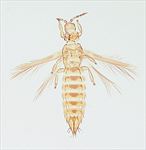Distinguishing features
Female macroptera. Body and legs mainly yellow; abdominal tergite II light across anterior half, III–VI with median and anterolateral dark areas (varying in size and intensity); antennal segment I white, II variable from pale to brown, III yellow to light brown, IV–V brown but sometimes with bases paler; fore wings weakly shaded except at apex; tergite IX setae light brown. Head wider than long with transverse sculpture lines behind eyes, extending weakly into ocellar triangle; eyes without pigmented facets; ocellar setae III varying in position from anterior margins of triangle to close together behind first ocellus. Antennae 9-segmented, III–IV with forked sense cone; II with very few microtrichia; VI pedicellate, suture transverse between VI–VII. Pronotum with transverse lines; with no long setae, discal setae relatively robust. Metascutum reticulate; median setae close to anterior margin; campaniform sensilla present. Fore wing first vein with about 9–11 setae on basal half, 2–4 setae medially, 2 setae distally; second vein with 12–16 setae including 1–2 setae basal to vein fork; clavus with 6–7 veinal setae. Abdominal tergites II–IV with a few sculpture lines medially, V–VII usually without such lines; laterally with about 8 anastomosing lines with broadly based, short microtrichia, sculpture extending just mesad of setae S2; VIII with long regular posteromarginal comb. Sternite VII setae S1 far anterior to posterior margin, S2 sometimes slightly submarginal.
Male macroptera. Similar to female; tergite IX with one pair of stout median thorn-like setae, posterior margin with pair of greatly elongate, recurved “setae”; sternites III–VII with large C-shaped pore plate.
Larva II. Body and legs mainly yellow, antennal segments shaded; tergite IX shaded posterior to major setae, X shaded in distal half; all dorsal setae slightly to broadly expanded at apex; tergites with transverse rows of prominent plaques; IX posterior margin with small but prominent pointed tubercles.
Related species
The males of A. dubius have a pair of uniquely recurved “setae” on the posterior margin of tergite IX, but these do not appear to have typical setal bases.They may be homologous with smaller structures in a similar position on the males of A. desleyae and A. epacrida. There are 43 species of Anaphothrips known from Australia (Mound & Masumoto, 2009), out of a total of 86 species worldwide (ThripsWiki, 2020). Many of these species have the antennae clearly 9-segmented, others clearly have only 8 segments, but several species have an intermediate condition with segment VI bearing a partial and often oblique transverse suture.
Biological data
Adults and larvae from Pandorea sp. [Bignoniaceae] and Xerochrysum bracteatum [Asteraceae]; adults taken from Urtica sp. [Urticaceae] and Dodonaea viscosa [Sapindaceae].
Distribution data
Recorded from Queensland, New South Wales, Australian Capital Territory, and Northern Territory.
Family name
THRIPIDAE - THRIPINAE
Species name
Anaphothrips dubius (Girault)
Original name and synonyms
Heterothrips dubius Girault, 1926: 2
Anaphothrips quinqueguttatus Girault, 1927: 2
Anaphothrips regalis Girault, 1928: 2
Hemianaphothrips (Anaphothrips) tersus Morison, 1930: 9.
References
Mound LA & Masumoto M (2009) Australian Thripinae of the Anaphothrips genus-group (Thysanoptera), with three new genera and thirty-three new species. Zootaxa 2042: 1–76. http://www.mapress.com/zootaxa/2009/f/zt02042p076.pdf





